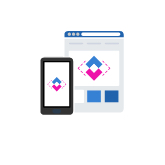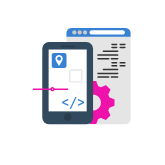In this article, we’ll be taking a look at some of the factors that influence how long it might take to build your Application and how you can arrive at a realistic timeframe.
So, how long will it take to build my App?
The honest answer to that is at this stage of your journey, no one actually knows!
When you’re trying to understand how long your project will take to build, the answer is; how long is a piece of string? Let’s take a look at why that seemingly casual statement is actually true.
But before I do, let me ask you this; how long does it take to build a house?
If your first thought was ‘I have no idea, it depends on how big the house is, where it’s located, how many rooms it has, if it has a big garden or a pool’ then you’ll already have a good idea of why it’s impossible for any software developer to give you a meaningful up front estimate of how long your Application might take to build.
Ok, so when can they tell me?
In the early stages of the project you very likely have a great idea of the broad functionality (stuff that your App can do) that you want to see in your Application. You might also have a solid understanding of your target user and you might even have done some early stage branding work to give your idea a look and feel.
All of this is fantastic and will go a long way towards saving you time when you start working with a team of professional software developers.
But here’s the thing, what we and virtually all development companies have experienced is how much things change once you move into the first real stage of software development; the scoping process.
During scoping, you might work with a team that looks something like this;
- project manager – to take overall control of the journey of building your Application
- business analyst – to help you understand how the Application might reflect your business model
- senior developer – to make sure we can achieve what you want using currently available technology
- UX/UI designer – to make sure your Application provides a wonderful experience and that your users can find what they want quickly
Regardless of what the actual team looks like, you can bet they will have a vast amount of experience taking fantastic concepts and turning them into great products. Invariably they will come up with new ideas and ways to achieve your goals that you hadn’t thought of. After all, that’s their job and they do it day in, day out.
During scoping, all ideas will be put on the table for consideration and that’s a positive thing, you definitely want that.
Given what we’ve just looked at I’m sure you won’t be surprised to learn that, after spending time really unpacking your concept and drilling into the details, the early stage idea you started with at the beginning of the scoping process will look quite different by the end of it.
In other words, you might have come into it thinking you were building a two story townhouse with a pool but you ended up realising you actually want a bungalow!
And this is exactly how it should be, it’s a healthy and normal part of the process of fleshing out and organically maturing your idea.
It’s also at the heart of why, only after scoping, can you get a good idea of how long your Application will take to build.
That makes sense, can you tell me some of the things that affect how long it will take?
There are some common functions or Application requirements that just unavoidably take time to implement. When a developer hears that a client is considering any of these they will already know – and should point out to you – that this will have an effect on your timelines.
Here’s a few things to look out for;

Integrations: This is when your new App needs to be connected to another existing third party App to perform a specific action or set of actions. A common example of this is payment gateways that handle payments from subscribers or users. By no means are all integrations tricky but if your App has multiple integrations the risk that one or more will prove troublesome grows exponentially. Multiple integrations can potentially cause significant cost blowouts.

Cutting edge technology: Incorporating specialised technology into your App can dramatically add cost. Apps with cool AI or machine learning are really awesome but believe me, what can look simple and seamless to us as users has not been achieved cheaply!

Hardware integration: As the Internet of Things (hardware with internet connectivity) gains real traction, there will be an uptick in the number of Apps that will want to connect with this hardware. Hardware integrations need a very careful investigation to understand how they will interact with a software application.

Desktop and native mobile Apps: Really think about whether your App needs to be available on both desktop and natively (installed on your phone) on mobile. Ask your scope team about mobile responsive web applications versus native applications. If you really want both, you’re looking at two separate codebases which will naturally add cost. It’s like building 2 houses on the same block of land instead of one.

Under Scoping: We can’t stress enough the importance of dedicating enough time and budget to scoping work. This is your chance to fully unpack and learn about the best ways your App can deliver maximum value to your users for the minimum budget spend. It is vitally important to know with as much certainty as possible what you are about to build before you start actually writing code. The last place you want to be experimenting is during the build phase of the project. This inevitably causes what’s called ‘scope creep’. Scope creep is when a client keeps adding more and more functionality into the App after the building work has started. It causes confusion and fosters inefficiencies. Our advice, don’t undercook your scoping!
Our advice, don’t undercook your scoping!
Judging how long an Application will take to build before scoping is close to impossible, in the same way, that you can’t possibly know long it will take to build a house before any plans have been drawn up and fixtures and fittings are chosen.
Apart from making sure you’re aware of the things we just looked at, the best way to keep your build time to a minimum is to start small and enhance your App over time. Pick a single compelling problem that you want to solve for your users and just build a solution for that. This approach is called the Minimum Viable Product or MVP approach. You might have seen this acronym or heard people talk about it.
If you really must get an idea of how long your App might take to build, there are companies that will give you a pre scope estimate based on broad categorisations. For example, a small, medium or large project. But the good ones will make the time range broad to take into consideration what they don’t know at that time. They should also make a point of explaining that any pre scoping cost estimate is very much an uncertain number.
You might want to think of it as a guesstimate.
Good luck with your project!
About the Author
With many years of experience working in the software development industry and based in Brisbane, Australia, Blair Williams has learned a lot about development and intends to share this knowledge to make the process of his clients easier.